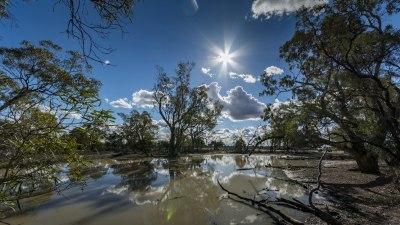Why Wind Never Knows When to Stop and Go Home
Explore the unpredictable nature of wind patterns and their impact on weather and environment.

This image was created with the assistance of Freepik
Wind is one of nature's most enigmatic phenomena, a force that is both invisible and palpable, carrying with it various implications for the environment and weather patterns. Understanding why wind behaves the way it does can be a complex endeavor, influenced by a variety of factors including temperature, pressure changes, and geographic elements.
To comprehend the mechanics behind wind, we must first explore its origins. Wind is essentially air in motion. The driving force behind this movement is the uneven heating of the Earth's surface by the sun. Some areas heat up more quickly while others remain cooler, creating differences in air pressure. Wind naturally flows from high-pressure areas to low-pressure areas in an attempt to equalize these discrepancies. This fundamental principle of wind movement is vital to understanding why it seemingly never knows when to stop.
The Role of Temperature
Temperature significantly influences wind patterns. During the day, surfaces such as land and water heat up to varying degrees due to solar radiation. For example, land heats up faster than water. Consequently, air above the land becomes warmer and rises, resulting in lower pressure in that area. Cooler air from over the water then moves in to replace it, creating a breeze. This process explains why coastal areas often experience consistent winds that change in intensity during the day.
At night, the reverse occurs; land cools quickly while water retains heat, leading to the development of land breezes as cool air settles over the land. Such daily temperature changes create a cyclical wind pattern, illustrating just one of the many factors that influence how and when the wind blows.
Pressure Systems
Pressure systems also play a crucial role in determining wind direction and strength. High-pressure systems are generally associated with fair weather and light winds, allowing for stable, clear skies. Conversely, low-pressure systems are linked to stormy conditions and often result in stronger winds. These systems can travel great distances, influencing wind patterns far from their point of origin. For example, a low-pressure system moving through a region can generate gusts that seem erratic, as the wind shifts direction based on the surrounding air pressure changes.
Understanding how these pressure systems work together is key to grasping why wind has a tendency to go on and on without a clear endpoint. The interconnectedness of weather patterns means that even as one system dissipates, another can take its place, perpetuating the cycle of wind.
Geographic Factors
Geography plays an essential role in shaping wind patterns. Mountains, valleys, buildings, and other structures can significantly affect how wind moves across a landscape. For instance, when wind encounters mountains, it is forced to rise, often cooling and condensing into clouds as it climbs. This can create stormy weather on the windward side and drier conditions on the leeward side, known as the rain shadow effect. The turbulence created by these geographic features contributes to the wind's unpredictability.
Furthermore, urban areas can create their own localized winds known as urban heat islands. These phenomenon occur when cities absorb more heat during the day than surrounding rural areas, resulting in localized wind patterns. This further complicates our understanding of when wind will stop or pick up, as urban landscapes interact with prevailing winds in unique ways.
The Coriolis Effect
The Coriolis effect is an important atmospheric phenomenon that arises from the Earth’s rotation. As air moves from high- to low-pressure areas, the curvature of the Earth causes the wind to be deflected, resulting in circular wind patterns. In the Northern Hemisphere, this deflection occurs to the right; in the Southern Hemisphere, to the left. This principle helps shape large-scale wind patterns like trade winds, which are consistent, predictable winds found in tropical regions. Understanding the Coriolis effect provides valuable insights into global wind patterns and can help explain why the wind often seems to have a mind of its own.
For instance, these trade winds contribute to ocean currents, which in turn influence climate and weather in various regions. When we consider the impact of the Coriolis effect, it becomes clear that wind influences not only local conditions but also global patterns, contributing to its continuing activity.
Seasonal Changes
Seasonal changes drastically affect wind patterns. During winter months, cold air settles in certain areas, creating high-pressure systems, while warmer air in other regions creates low-pressure systems. The contrast between these temperatures drives the wind, resulting in much stronger winds during winter months compared to summer. Conversely, summer often sees more stable atmospheric conditions, resulting in lighter winds. This variability is influenced by the Earth’s tilt and orbit, leading to seasonal weather changes that dictate when and where the wind blows.
Additionally, phenomena such as El Niño and La Niña can lead to drastic alterations in wind patterns across the globe. For instance, during an El Niño year, trade winds may weaken, changing weather patterns across wide geographical areas. These seasonal and irregular changes showcase the complexity of wind and illustrate the reasons why it appears to endlessly swirl and rush around.
Wind Patterns and Climate Change
In recent years, the conversation around wind has expanded to include the effects of climate change. As global temperatures rise, traditional wind patterns are being altered. Changes in temperature and pressure can lead to more intense and erratic wind events. For example, warmer oceans can lead to stronger tropical storms, thus increasing wind speeds. Furthermore, the interactions between the atmosphere and oceans are complex and can lead to feedback loops, which may amplify wind effects.
Additionally, the melting of polar ice caps and changes in land usage contribute to shifts in how and why winds blow. This underscores the urgency of understanding wind phenomena, as they are not just natural occurrences, but also integral to the broader context of climate dynamics.
Wind in Nature and Its Importance
Wind serves as an essential component of the Earth’s ecosystem. It facilitates the process of pollination, dispersing seeds and helping plants to thrive in various ecosystems. Additionally, wind plays a critical role in weather patterns and in the distribution of moisture. It aids in evaporating water from oceans and lakes, which then forms clouds and generates precipitation. This interconnectedness illustrates that wind is not merely an inconvenience or a mere phenomenon; it is, in fact, a driving force behind many ecological processes.
The importance of wind also extends into human applications, including renewable energy. Wind power has gained considerable traction as a clean energy source, harnessing the ever-present movement of air to generate electricity. This sector has seen rapid growth, illustrating the intersection between understanding wind dynamics and developing sustainable practices.
In summary, the unpredictability of wind is a result of a myriad of factors, including temperature variations, pressure systems, geographic features, seasonal changes, and even aspects of climate change. Each element plays a crucial role in creating a dynamic and ever-changing atmosphere. By gaining insights into these factors, we can improve our understanding of wind and its implications for our world. Wind may never truly know when to stop or go home, but we can certainly gain a better grasp of its behavior and the profound impact it has on our environment and lives.











